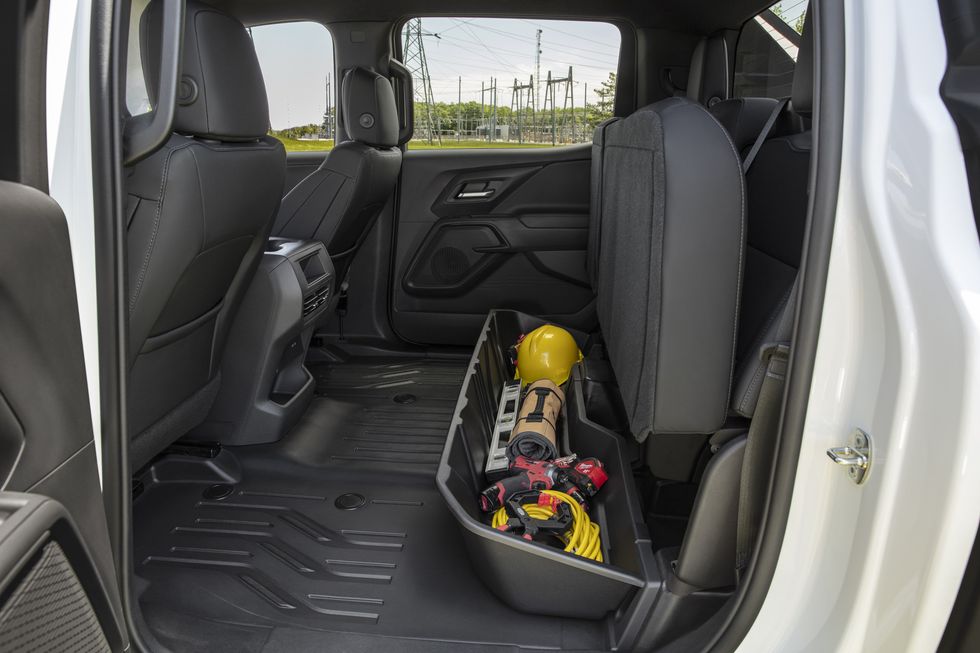2024 Chevy Silverado EV 4WT Gets to Work

Things are heating up in the electric pickup segment. Rivian’s R1T makes for a bold initial showing from the startup manufacturer, while Ford’s F-150 Lightning is a strong counteroffensive aimed at warming up customers to the idea of a traditional full-size truck powered by electrons. General Motors, on the other hand, went full send with the outrageous GMC Hummer EV SUT, which forms the basis for the latest player on the field, the 2024 Chevrolet Silverado EV. Although the bow-tie brand has only let us drive a fleet-specific 4WT model thus far, this relatively humble work truck serves as a primer for what we can expect when the first customer models go on sale later this year.
Casting the silhouette of a born-again Chevy Avalanche, the Silverado EV is a clean-sheet design that shares virtually nothing in common with existing internal-combustion Silverados. Think of it as a more palatable version of the bonkers Hummer, with the simplified 4WT model outfitted for the roughly 350 fleet customers who’ve raised their hands for highly capable, long-range electric trucks they can integrate into their job sites. For Chevrolet, the benefits of this approach include a single initial build configuration, plus valuable feedback on how its new rig handles rigorous duty cycles, or so the thinking goes.
A Compelling Foundation
The 4WT is a no-frills alternative to the Silverado EV RST First Edition that Chevy will release to the public this fall. That truck’s dual-motor, all-wheel-drive powertrain will produce up to 754 horsepower and at least 785 pound-feet of torque, and it will feature standard air springs, rear-wheel steering, a removable mid-gate bed extender behind the passenger compartment, and upscale interior furnishings that better reflect its $106,895 starting price. In contrast, the dual-motor 4WT is spartan inside, rides on conventional coil springs, and does without the mid-gate and rear-steering hardware. Output comes in at a tamer 510 horses and 615 pound-feet.
However, both initial Silverado EV models feature the same Ultium battery pack—a 24-module, 2923-pound behemoth—shared with the Hummer EV pickup. Based on Chevy’s claim that it has slightly improved upon the estimated 205.0 kilowatt-hours of usable capacity in the GMC’s pack, we estimate the 4WT’s battery at 215.0 kilowatt-hours—enough to earn it a 450-mile range figure from the EPA (the RST is rated for 400 miles, and a 3WT with a lesser pack and a 350-mile range launches later). It’s also enough juice to support the truck’s seven power outlets, including an array of hookups in the bed, which together provide up to 7.2 kilowatts of power to run a suite of tools and appliances—even your house for limited periods. Adding an accessory inverter increases those figures to 10 outlets and a heady 10.2 kilowatts. Unlike GMC with the Hummer, Chevy will print the Silverado’s not-great MPGe efficiency numbers (63 combined/67 city/59 highway) on its window sticker even though its weight is far above the 8500-pound GVW threshold where the company doesn’t have to.
The Silverado EV employs a 400-volt architecture, but a neat trick that allows the two layers of its battery pack to switch from a parallel to series connection for fast-charging allows it to charge at 800 volts and gobble electrons at up 350 kilowatts. Chevy claims that 100 miles of range can be added in around 10 minutes. GM’s integrated charging network currently encompasses more than 130,000 locations. More will be added in the coming years as its EVs are adapted for compatibility with Tesla’s 12,000-unit network of U.S. fast chargers, with the eventual goal being GM’s full-scale switch to Tesla’s North American Charging Standard (NACS) plug. Perhaps just as important for those operating in remote areas, the Silverado EV also can be used to offload power to other EVs.
Chevrolet

Chevrolet
The Silverado EV 4WT’s range, combined with an estimated 60-mph time of 5.4 seconds, is respectable considering the truck weighs around 8500 pounds—about half a ton less than the last Hummer EV pickup we tested yet still heavy enough to crush our scales, not to mention almost anything that gets in its way. But Chevy has made good use of the Silverado EV’s foundation: The 4WT is now rated to tow up to 10,000 pounds (up from Chevy’s early 8000-pound estimate) and is good to haul 1440 pounds (up from 1200) in its five-foot-11-inch cargo bed. It also can swallow several carry-on bags in its 11-cubic-foot frunk. For a rough comparison, Ford’s significantly lighter F-150 Lightning (by more than 1600 pounds) tops out at 320 miles of range, while its towing and hauling maximums stand at 10,000 and 2235 pounds, respectively.
Form and Function
As a full-size truck, the 4WT EV is only marginally more massive than a conventional half-ton, crew-cab, short-bed Silverado. At 81.6 inches wide, it’s 5.1 inches narrower than the Hummer EV pickup, yet its 233.1-inch length stretches 16.3 inches longer. While the RST First Edition will sit on flashy 24-inch wheels, the 4WT trucks we drove had 18-inchers wrapped with LT265/70R-18 Bridgestone Alenza A/S 02 all-season tires. The EV’s futuristic design contributes to a slippery drag coefficient of 0.33, making it the most aerodynamic GM truck extant, but there’s no mistaking this rig for anything but a Silverado.
Step inside the 4WT with its low door sills and flat, rubber-covered floor, and you’re greeted by a sea of dark, grained plastic that’s rather depressing considering this model’s $79,800 starting price (excluding the available $7500 tax credit). But durability and ease of cleaning are the goals here, as no work truck leads a glamorous life. A simple-to-read 8.0-inch digital instrument cluster is standard, as is an 11.0-inch center touchscreen that frustratingly incorporates the headlight controls and the settings for the truck’s regenerative braking, which range from a little to full one-pedal operation. Thankfully, a row of simple climate-control buttons and dials sit below it. The column-mounted shifter frees up space in the center console for spacious storage cubbies, including a seven-gallon main compartment.
It’s the rear of the Silverado EV’s cabin that benefits the most from the truck’s cab-forward design and Chevy’s resulting decision to scoot the front seats forward. Stretch-out space in back is limousine-like, with the EV’s 44.3 inches of legroom extending about an inch farther than a regular Silverado crew cab’s. The rear seatbacks fold up to reveal additional storage. If this were a fancier model with the mid-gate feature, the rear bench could be folded down into the floor, effectively lengthening the cargo hold to a little over nine feet.
A Refined Workhorse
Current GM truck owners will quickly acclimate to piloting the electrified Silverado. The 4WT moves along with the quiet refinement expected of an EV, with a synthesized hum playing through its stereo speakers only under hard acceleration. It feels as quick as any Silverado we’ve driven, with a responsiveness that makes short work of passing maneuvers on country roads. Even when hooked to a 9000-pound construction trailer, the truck shrugs off the extra weight like a diesel-powered heavy-duty pickup. Activating Tow/Haul mode revises the programming of the EV’s powertrain for maximum performance, while the strength of its regenerative-braking system meant we barely needed to use its friction brakes when bringing the almost fully loaded truck to a stop on flat ground.
Aided by independent front and rear suspensions, plus a lower center of gravity compared to an internal-combustion Silverado, the 4WT’s driving experience is defined by its sorted composure. Say goodbye to the regular Silverado’s bump-induced wheel chatter from a primitive solid rear axle, and general maneuverability is quite good even without the help of rear-wheel steering. Though its soft suspension tuning and considerable body roll in corners keep you aware of its sheer size and mass, the Silverado’s steering is reasonably precise for a big truck, and its brake pedal is reassuringly firm. Add in the smoothness of the electric powertrain, and we often found ourselves traveling at higher speeds than we intended.
Of course, the Silverado EV does have a few caveats: Working it hard will drastically reduce its range, and fully replenishing such a massive battery will require lengthy pit stops even at fast-chargers. For Level 2 charging, the Silverado can manage only 11.5 kilowatts rather than the 19.2 kilowatts available on the Hummer, which means a full charge will take more than 20 hours as opposed to just over 12. Also, Joe consumer can’t buy one yet. But the 4WT model is an impressive workhorse for fleet operators willing to pay the price for early adoption—and it’s an exciting teaser for what’s to come. Along with the RST, additional Silverado EV variants will join the lineup over the next 18 months, including an off-road-oriented Trail Boss trim with a lifted suspension, as well as shorter-range models with more approachable prices. Ram’s electric 1500 REV pickup also should hit the streets in that timeframe, at which point this bourgeoning segment will be ripe for its first proper comparison test.
Arrow pointing downArrow pointing down
Specifications
Specifications
2024 Chevrolet Silverado EV 4WT
Vehicle Type: front- and rear-motor, all-wheel-drive, 5-passenger, 4-door pickup
PRICE
Base: $79,800
POWERTRAIN
Front Motor: permanent-magnet synchronous AC
Rear Motor: permanent-magnet synchronous AC
Combined Power: 510 hp
Combined Torque: 615 lb-ft
Battery Pack: liquid-cooled lithium-ion, 215.0 kWh
Onboard Charger: 11.5 kW
Peak DC Fast-Charge Rate: 350 kW
Transmissions: direct-drive
DIMENSIONS
Wheelbase: 145.7 in
Length: 233.1 in
Width: 81.6 in
Height: 78.0 in
Passenger Volume, F/R: 71/65 ft3
Front-Trunk Volume: 11 ft3
Curb Weight (C/D est): 8500 lb
PERFORMANCE (C/D EST)
60 mph: 5.4 sec
100 mph: 10.8 sec
1/4-Mile: 13.9 sec
Top Speed: 110 mph
EPA FUEL ECONOMY
Combined/City/Highway: 63/67/59 MPGe
Range: 450 mi

Technical Editor
Mike Sutton is an editor, writer, test driver, and general car nerd who has contributed to Car and Driver’s reverent and irreverent passion for the automobile since 2008. A native Michigander from suburban Detroit, he enjoys the outdoors and complaining about the weather, has an affection for off-road vehicles, and believes in federal protection for naturally aspirated engines.







